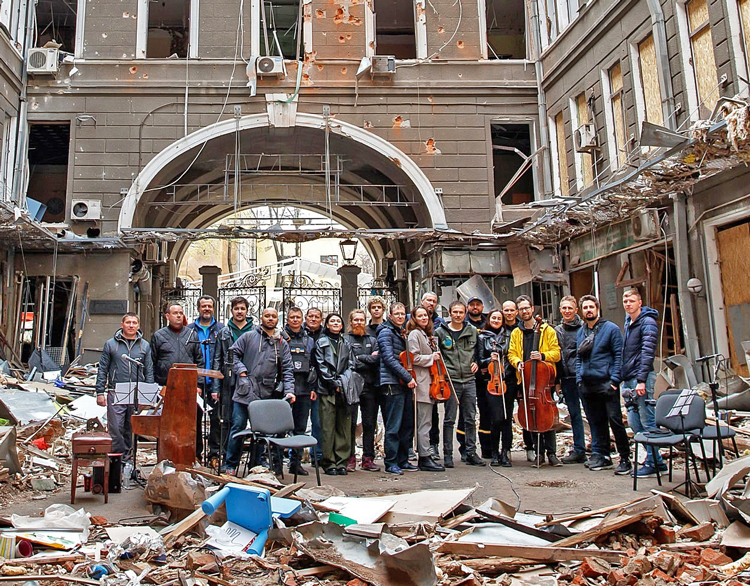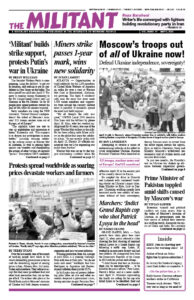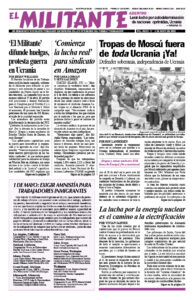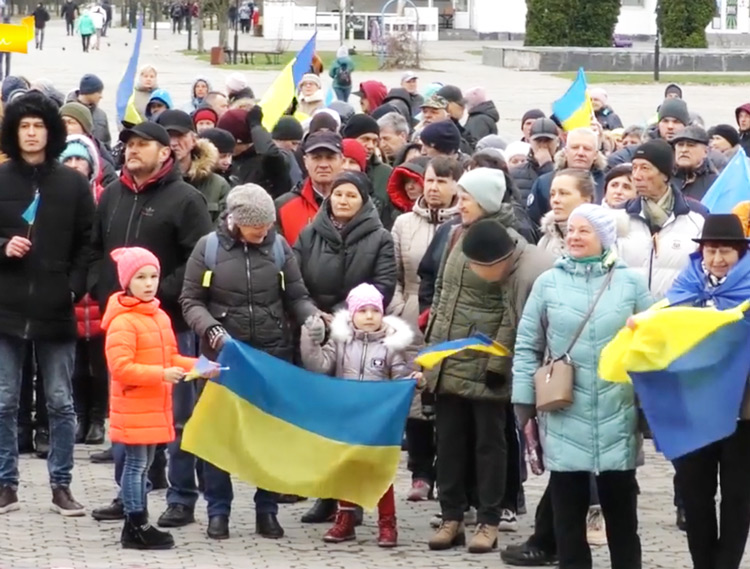Attempting to reverse a series of embarrassing setbacks in his effort to crush independent Ukraine, Russian President Vladimir Putin launched an offensive April 18 in the eastern part of the country closest to Russia.
He coupled the drive in Donetsk and Luhansk with continued bombing attacks on Ukraine’s major cities, from Kharkiv to Kyiv, Lviv to Dnipro. Ukrainian working people have mounted nearly two months of tenacious defense of their sovereignty, forcing Russian units to retreat from the entire region around the capital, Kyiv, as well as Chernihiv, Sumy and Kharkiv. Moscow’s withdrawal has revealed a trail of civilian deaths and massive destruction.

In just two months, the Kremlin’s war on Ukraine has shaken up alliances between imperialist governments worldwide as the capitalist rulers search for how best to defend their national interests. The invasion has disrupted trade and delivery of everything from wheat to oil and increased the volatility of financial markets. Every capitalist regime is beefing up its military capacity in anticipation of more wars to come.
Russian forces launched an attack on Ukrainian defensive lines dug in along a nearly 300-mile front in an arc from Kharkiv in the northeast through Luhansk and Donetsk to the still surrounded and besieged city of Mariupol in the southeast, to Kherson further west. “The battle for Donbas,” which is the main industrial and mining region in Ukraine, looms.
Amassed Russian troops and tanks are being hurled at Ukrainian defenses in a drive to conquer territory adjacent to the parts of Donetsk and Luhansk that Moscow-backed separatists, reinforced by Russian agents, seized in 2014. This covered roughly a third of the two Ukrainian provinces. While Putin claims the inhabitants there are all Russians, he is planning a massive war against them.
While the Russian military commands much greater heavy armor and air power, its growing number of troops there are weakened by earlier losses and morale problems. They also face determined resistance by 40,000 Ukrainian soldiers and volunteers seasoned in battle since the 2014 conflict and today’s combat.
‘Butcher’ of Aleppo and Grozny
Putin showed the kind of slaughter he plans to inflict by appointing a new overall commander of his war against Ukraine, Gen. Alexander Dvornikov. Known as the “butcher” of Aleppo, Dvornikov was in charge of Moscow’s intervention to back the crumbling Syrian dictatorial regime of Bashar al-Assad. “Dumb” bombs were used to pulverize Aleppo and other Syrian cities held by rebel forces. Tens of thousands were killed and the city reduced to rubble.
Dvornikov also led the bloody siege of Grozny when Chechens rose up to fight for independence from Russia in 2000. After massive bombardment, his troops moved in, shooting anyone they saw. Most recently he has been in charge of Moscow’s occupation of Crimea and its relentless assaults against the oppressed Tatar people there.
Kyiv says over 900 Ukrainian towns and villages have been freed from Russian occupation. Counterattacks pushed Russian units back from around Kharkiv and in the south, near Kherson, the only major city taken by Russian forces so far.
“The Socialist Workers Party hails the courageous resistance by Ukrainians, arms in hand, and the protests Ukrainian working people have mounted in occupied areas to defend Ukraine’s national sovereignty and independence,” Joe Swanson, Socialist Workers Party candidate for U.S. Congress from Nebraska, said April 19. “We also hail the vanguard protests in Russia against Putin’s invasion of Ukraine, despite growing repression there.
“The governments in Washington and Europe cry crocodile tears for the Ukrainian people, while their real aim is to defend the markets and predatory interests of their imperialist rulers,” he said. “The far-reaching sanctions imposed by the U.S. rulers and their allies, whatever their supposed ‘target,’ in fact fall heaviest on working people in Russia. They make it more difficult for Ukrainian workers and farmers to forge links of solidarity with working people in Russia, the class forces needed to build mounting pressure on Moscow to back off.
“No capitalist rulers anywhere have any interest in the deepening solidarity of working people,” Swanson said.
Thousands of besieged Ukrainian defenders in the strategic port of Mariupol ignored Moscow’s latest ultimatum to surrender April 20. This last holdout resistance continues to frustrate Putin’s goal to secure the city, creating a “land bridge” to the occupied Crimean Peninsula.
After weeks of heavy street fighting and constant bombardment, Russian troops have taken most of the city, which has been reduced to rubble. But 3,000 Ukrainian fighters have regrouped, along with at least 1,000 civilians, holed up in a maze of tunnels under the giant Azovstal steelworks, one of the largest in Europe. They have been targeted by Tupolev heavy bombers with bunker-buster bombs.
The devastating siege of Mariupol gives the lie to one of Putin’s rationales for his invasion — that he is intervening to protect Russian speakers in Ukraine from “genocide” at the hands of Kyiv’s “Nazi” government. According to Ukrainian officials, at least 21,000 mainly Russian-speaking civilians have been killed there by Moscow’s siege, punished for refusing to embrace Putin’s invasion. Those that remain have become ever stauncher supporters of Ukraine independence.
Russian toilers question Putin’s war
The April 14 sinking of the Russian warship Moskva, the flagship of Russia’s Black Sea fleet, has raised anger and questions from family members of missing or injured sailors back home.
Kyiv said its rockets hit the missile cruiser, with a crew of nearly 500. Moscow claimed the fire was an accident and the ship sank in bad weather.
Irina Shkrebets, searching in a Crimean hospital for her sailor son, Yegor, saw at least 200 badly burned sailors there. “Where’s the rest of them?” she asked on Russian news outlet The Insider. After hearing their son was missing, her husband, Dmitry, posted on the online site VKontakte that Moscow said, “The entire crew had been evacuated. It’s a lie! A blatant and cynical lie!”
Another woman told Noveta Gazeta that her hospitalized sailor son hadn’t expected “to end up in such a mince-grinder in peacetime.” Numerous parents are searching for their missing sons who were conscripts, and weren’t supposed to be sent to combat zones.
Despite escalating troop losses, the Kremlin keeps up the fiction that it is only waging “a special military operation,” not a war. In fact, it’s a crime in Russia to say anything else.
The Kremlin clamped down on widespread protests in the immediate aftermath of the invasion, arresting over 15,000 demonstrators. A new law imposing jail terms of up to 15 years for “discrediting” the Russian military was passed and is being enforced, with hundreds more now facing charges.
Beneath Putin’s repressive crackdown, opposition to the war continues to bubble. The most visible sign of dissent in St. Petersburg has been the spread of green ribbons — symbols of opposition to the invasion — tied to lanterns, fences, statues and buildings. One man was detained outside the Kremlin for holding up a copy of Leo Tolstoy’s novel War and Peace. Others have been arrested for holding up blank pieces of paper, packages of food or even a bank card.
Kremlin critic Vladimir Kara-Murza was arrested in Moscow April 11 on charges of opposition to Putin’s “regime of murderers.” In an op-ed forwarded to the Washington Post by his lawyer, Kara-Murza said he was being held alongside hundreds of young anti-war protesters.
“When you are told that no one protests against the war in Russia, don’t believe it,” he wrote. “The night, as you know, is darkest just before the light.”


